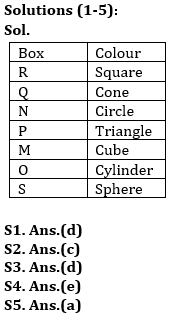Directions (1-5): Read the given information carefully and answer the questions given below;
Seven boxes M, N, O, P, Q, R and S are placed one above another, also they are of different shapes i.e., circle, sphere, cone, triangle, cube, cylinder and square (but not necessarily in the same order).
One box is placed between box N and box R. Three boxes are placed between box M and the box which is of square shaped but one of them is placed at top. Box P is of triangle shape. Box S is placed just below box O. Sphere shaped box is placed either at top or at bottom. Box P is placed above box O but below box Q. Box R is of square shaped. The box which is placed just below M is of cylinder shape. Box N is not of cube shaped box. Cone shaped box is not placed just above box P. Two boxes are placed between box N and box O. Box M is placed below the box which is of the cone shaped.
Q1. What is the shape of Box O?
(a) Circle
(b) Square
(c) Cone
(d) Cylinder
(e) None of these
Q2. Which of the following box is placed at top?
(a) Box N
(b) Box S
(c) Box R
(d) Box M
(e) None of these
Q3. How many boxes are placed between box Q and box S?
(a) One
(b) Three
(c) Two
(d) More than three
(e) None of these
Q4. Which box is placed just above box N?
(a) S
(b) P
(c) The box which is of cone shaped
(d) Q
(e) Both (c) and (d)
Q5. What is the shape of Box N?
(a) Circle
(b) Square
(c) Cone
(d) Cylinder
(e) None of these
Directions (6-10): In these questions, relationship between different elements is shown in the statements. The statements are followed by conclusions. Study the conclusions based on the given statements and select the appropriate answer:
(a) If only conclusion I follows.
(b) If only conclusion II follows.
(c) If either conclusion I or II follows
(d) If neither conclusion I nor II follows.
(e) If both conclusions I and II follow.
Q6. Statements: S≤W<O≥R≥G>D≥J
Conclusions: I. O>S
II. J<R
Q7. Statements: Q≤L>P=F<E<R=C
Conclusions: I. L>F
II. C>P
Q8. Statements: E>T=R<C≤P≥G
Conclusions: I. P>T
II. T>G
Q9. Statements: Z<X<T=E>S>L=C
Conclusions: I. S>Z
II. T>C
Q10. Statements: S=M≤ Q=I≤W>D
Conclusions: I. S=W
II. W>S
Solutions

Solutions (6-10):
S6. Ans(e)
Sol.I. O>S(True)
II. J<R (True)
S7. Ans(e)
Sol.I. L>F (True)
II. C>P (True)
S8. Ans(a)
Sol.
I. P>T(True)
II. T>G (False)
S9. Ans(b)
Sol.
I. S>Z (False)
II. T>C(True)
S10. Ans(c)
Sol.
I. S=W(False)
II. W>S (False)





 GA Capsule for SBI Clerk Mains 2025, Dow...
GA Capsule for SBI Clerk Mains 2025, Dow...
 The Hindu Review October 2022: Download ...
The Hindu Review October 2022: Download ...
 ECGC PO Cut off 2025 Out, Check Final Cu...
ECGC PO Cut off 2025 Out, Check Final Cu...




